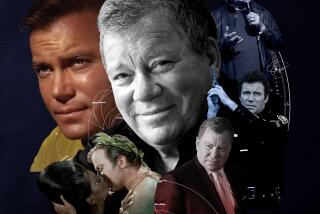Buddy DeFranco dies at 91; first clarinetist to master bebop
- Share via
Buddy DeFranco, a jazz clarinetist who played with the big swing bands of Tommy Dorsey, Charlie Barnet and Gene Krupa, the Count Basie Septet and the George Shearing Trio and is considered the first player to authentically play bebop on the clarinet, has died. He was 91.
DeFranco died Wednesday in Panama City, Fla., after a period of declining health, according to his wife, Joyce.
Admired for his mastery of the clarinet in his early career as a swing band musician, DeFranco came to full prominence in the late 1940s and early ‘50s. Although the clarinet had been a stellar swing-era instrument in the hands of bandleaders such as Benny Goodman, Artie Shaw and Woody Herman, it did not initially find a visible role when bebop arrived in the ‘40s.
“I was the first clarinetist to play bebop on the instrument,” DeFranco told the Columbus (Ohio) Dispatch in 1993. “It turns out that was the beginning of a dry spell for the clarinet in jazz. It was a very difficult instrument on which to play bop.”
The New Grove Dictionary described the task in even broader strokes, noting that the clarinet is “incompatible with bebop.”
But DeFranco disagreed. “I wouldn’t say incompatible,” he told the Dispatch. “It’s simply harder to play bop on clarinet than any other instrument.”
DeFranco nonetheless took on the challenge. By the late ‘40s he had thoroughly established himself as the principal bebop clarinetist. And he would remain so for decades, exploring and mastering other new jazz ideas as they arrived. His influence persisted on generations of clarinetists, reaching across a diverse array of players, from Jimmy Giuffre to Eddie Daniels, Ken Peplowski, Anat Cohen and dozens of others.
He was born Boniface Ferdinand Leonardo DeFranco on Feb. 17, 1923, in Camden, N.J., to Leonardo and Louise DeFranco. His father was a piano tuner and a guitarist.
DeFranco was raised in a troubled family environment — his father lost his sight before DeFranco was born, and his mother was institutionalized after an attempted suicide.
Music provided a distraction, and his talent began to surface at an early age. DeFranco played mandolin at 5 and clarinet and alto saxophone at 8.
At 14, he won a Tommy Dorsey national swing contest and performed on a Saturday night radio swing show with Gene Krupa. He attended the Mastbaum School of Music in Philadelphia and after graduating in 1939 joined the Johnny “Scat” Davis band. In 1941 he became a member of the Krupa big band, the first of several stints doubling on clarinet and saxophone with a string of big swing bands led by Dorsey, Barnet, Boyd Reyburn and others.
Moving to New York City in 1948, DeFranco arrived at a time when the jazz world was being transformed by startling new improvisational ideas called “bebop” that were being advanced by gifted young jazz artists such as alto saxophonist Charlie “Bird” Parker, trumpeter Dizzy Gillespie and pianist Bud Powell.
DeFranco was drawn to what he heard, well aware that bebop had not produced a clarinetist to match the adventurous playing advanced by Parker, in particular. “It was Charlie Parker,” he often said, “who completely turned me around.”
“I decided,” he told writer Ted Panken in Down Beat, “to play the clarinet like Bird articulated on the sax.” And he did so with a deeply effective sense of rhythmic swing that was also inspired by Parker.
Despite his successes as a bebop clarinetist, however, DeFranco, like other bebop players, found employment possibilities marginalized by the challenging aspects of the music. In the late ‘50s, he was drawn back to his original swing roots when he took over the leadership of the Glenn Miller Orchestra from 1966 to 1974, playing the long list of the Miller non-bebop hit songs from the swing era.
In later years, he returned to more challenging music during a lengthy, musically diverse partnership with vibraphonist Terry Gibbs, whose musical history — like DeFranco’s — reaches back into the bebop of the post-World War II years.
DeFranco recorded dozens of albums under his own leadership. And his resume includes musical associations with artists such as Gillespie, Art Tatum, Billie Holiday, Stan Getz, Nelson Riddle, Billy Eckstine and Oscar Peterson, attesting to an artistic versatility reaching beyond his well-deserved fame as the first bebop clarinetist.
In 2006 DeFranco received an NEA Jazz Masters Award. And, over the course of his long career, he consistently placed at the top of the jazz clarinet category in polls by Down Beat, Jazz Times and Playboy.
DeFranco is survived by his wife, Joyce, and their son, Charles “Chad” DeFranco.
More to Read
Start your day right
Sign up for Essential California for the L.A. Times biggest news, features and recommendations in your inbox six days a week.
You may occasionally receive promotional content from the Los Angeles Times.






